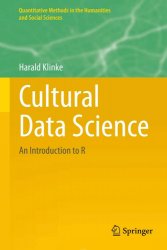Cultural Data Science: An Introduction to R
- Добавил: literator
- Дата: 16-05-2025, 17:29
- Комментариев: 0
 Название: Cultural Data Science: An Introduction to R
Название: Cultural Data Science: An Introduction to RАвтор: Harald Klinke
Издательство: Springer
Год: 2025
Страниц: 163
Язык: английский
Формат: pdf
Размер: 16.9 MB
This book addresses growing demand in the visual humanities for foundational knowledge in data analysis, image processing, and Artificial Intelligence (AI). Intended for readers without prior technical knowledge, its eighteen chapters introduce key concepts in Data Science through examples from art history, visual computing, and cloud technologies. For advanced readers, it explores how digital methods enhance our understanding of our cultural past. Focusing on image-based humanities research, the book demonstrates practical applications using open source software such as R, RStudio, and ImageMagick, along with open data sets from institutions like the MoMA, the Met, and the Rijksmuseum.
To effectively analyze data, the choice of means is crucial. In this book, we are using the programming language R as a strategic choice, since it offers distinct advantages over alternative means. R, being an open-source language, accommodates a wide spectrum of data analysis tasks. Its extensive community contributes to a growing ecosystem of packages and tools across diverse domains, enhancing its adaptability for cultural data exploration. R is particularly strong in data visualization with libraries like ggplot2 and plotly, providing users with the ability to generate visually compelling and informative graphs. The expansive package repository equips R with a rich set of tools covering a broad spectrum of data analysis and statistical tasks. R’s heritage as a statistical language positions it as a preferred choice for data analysts.
R’s specialization in statistical operations often leads to the creation of more efficient and concise code for such analytical tasks. R’s syntax and functions are frequently deemed more intuitive, particularly when it comes to data wrangling activities. The R community is tailored specifically to statistical computing and data analysis, fostering the development of highly specialized packages.
RStudio serves as the graphical interface for the R programming language, providing a user-friendly environment for data analysis, visualization, and coding. When installing RStudio, it is important to understand the relationship between R and RStudio.
R itself is the core programming language, represented as the command-line interface typically seen in the lower-left corner of the RStudio window. In this context, RStudio can be considered as an integrated development environment (IDE) that enhances the functionality and user experience of R. It serves as a comprehensive platform for writing, running, and visualizing code.
Ideal for students, researchers, and professionals in art history, digital humanities, and museum studies, this book bridges the gap between technology and the humanities, making complex digital methods accessible to a broad audience.
Скачать Cultural Data Science: An Introduction to R
[related-news] [/related-news]
Внимание
Уважаемый посетитель, Вы зашли на сайт как незарегистрированный пользователь.
Мы рекомендуем Вам зарегистрироваться либо войти на сайт под своим именем.
Уважаемый посетитель, Вы зашли на сайт как незарегистрированный пользователь.
Мы рекомендуем Вам зарегистрироваться либо войти на сайт под своим именем.
